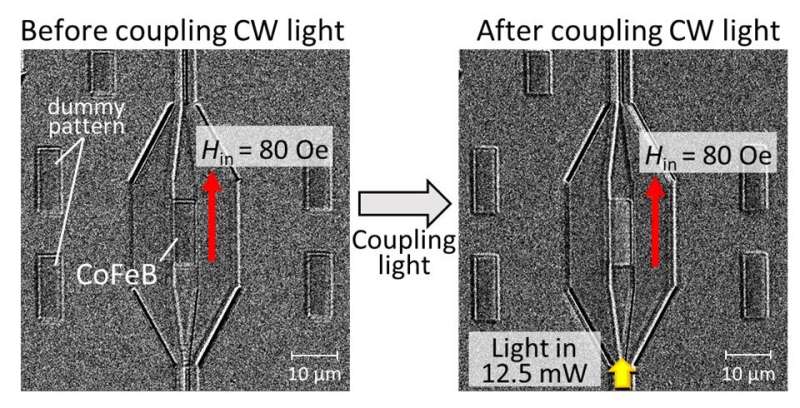
Researchers have shown for the first time that light can cause thermomagnetic recording in a magnetic thin-film. The new writing technique is poised to enable miniature high- performance magneto-optical memories that don't require bulky optics or mechanical rotation.
Magnetic and optical recording techniques are used to store information. Although several companies once made rewritable magneto-optical disk drives, they are rarely used today.
Despite their significant advantages, magneto-optical drives have been replaced by cheaper flash drives or optical storage media such as DVDs.
The researchers describe their new light-based writing technique in a journal. The devices are nonvolatile, meaning that data can be saved even when there is no power to the device.
The use of on-chip magneto-optical memories could enable all-optical alternatives to the electronic packet routers used in today's telecommunications infrastructure.
Light controlling magnetism.
A small spot on a magnetic film above a critical temperature known as the Curie point can be demagnetized with heat. When the spot cools, a local applied magnetic field determines the direction in which it is magnetized. Light propagating in a waveguide is needed to control the magnetic state of a magnetic film inside the circuit.
The researchers developed a way to reverse the direction of the magnetization by heating the magnetic recording film near the Curie temperature. Their approach allows the material to be easily aligned with the applied magnetic field.
The researchers used a thin-film magnet to demonstrate the new technique. They were able to measure the film's magnetic properties using a special high-resolution magneto-optical Kerr effect microscope. The coercive force of the magnet depends on the heat that is generated by light in the waveguide.
When light was launched into the waveguide, we observed that the magnetization direction would flip under a proper biasing magnetic field.
The researchers want to develop solid-state magneto-optical recording systems that can not only write but also read information using the new method. Reducing the energy consumption of light-generated thermomagnetic recording will require using a magnetic recording medium with a smaller volume and a shorter light pulse.
More information: Toshiya Murai et al, Light-induced thermomagnetic recording of thin-film magnet CoFeB on silicon waveguide for on-chip magneto-optical memory, Optics Express (2022). DOI: 10.1364/OE.448460 Citation: Researchers use light for thermomagnetic recording on silicon waveguide (2022, May 10) retrieved 10 May 2022 from https://phys.org/news/2022-05-thermomagnetic-silicon-waveguide.html This document is subject to copyright. Apart from any fair dealing for the purpose of private study or research, no part may be reproduced without the written permission. The content is provided for information purposes only.